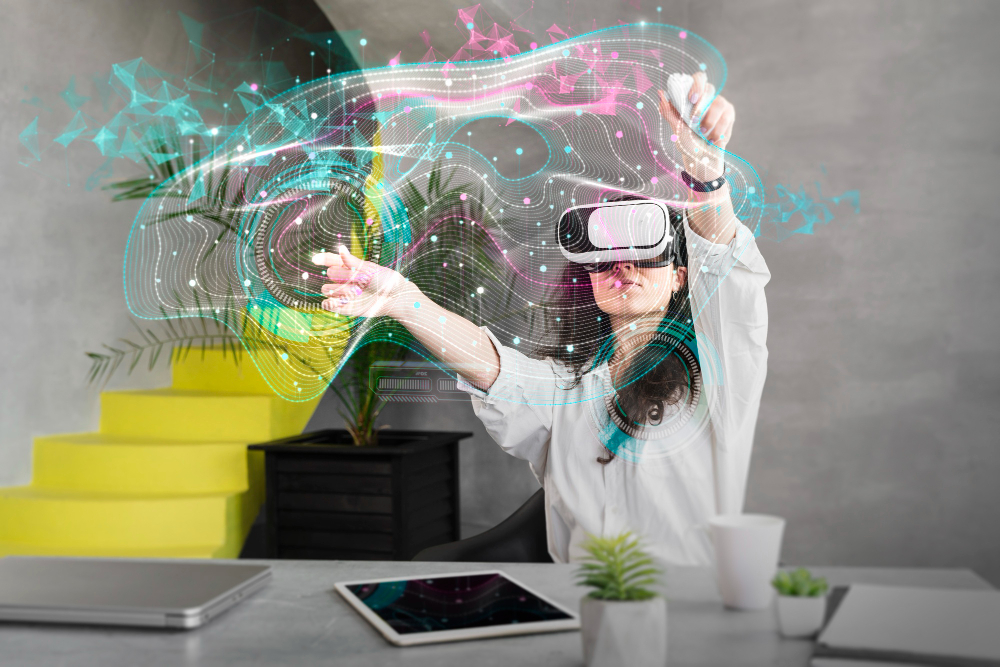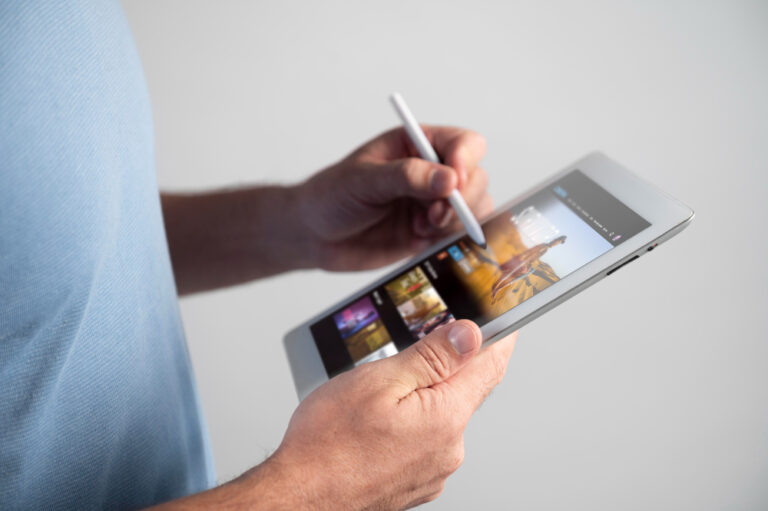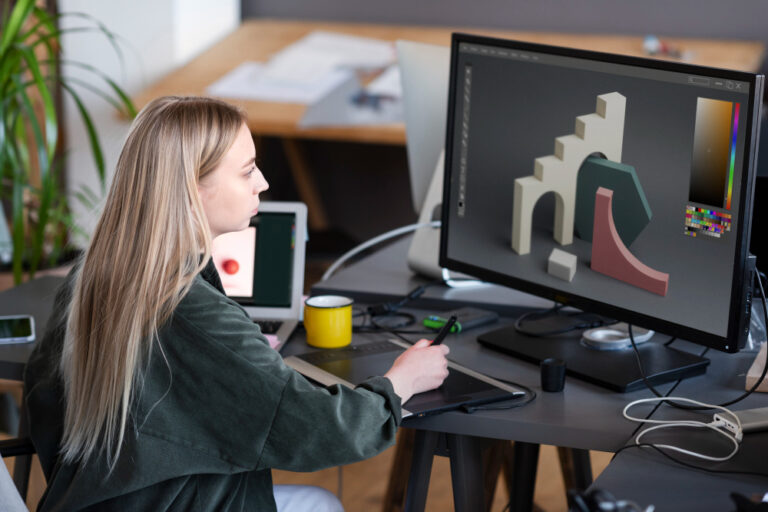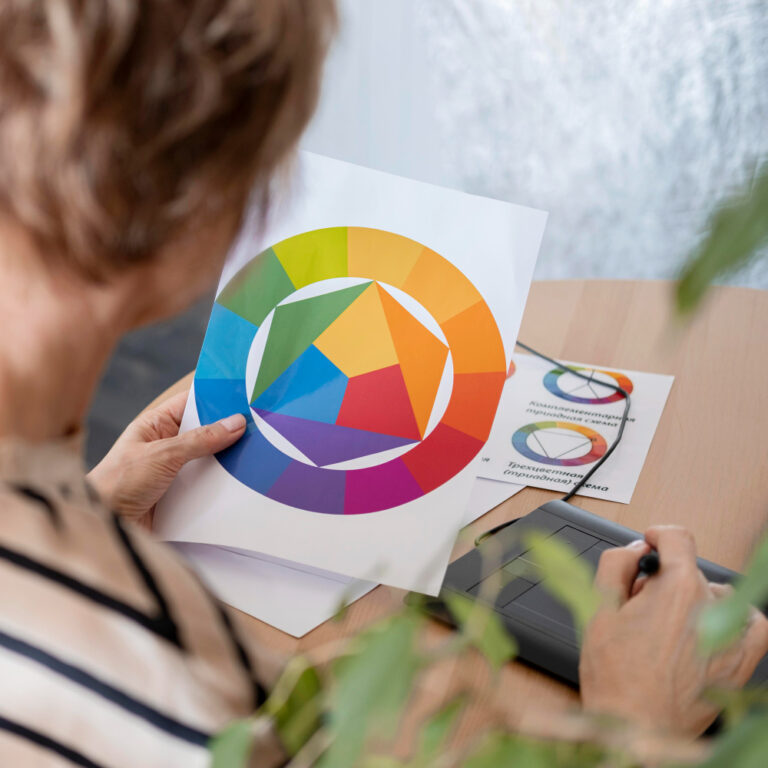Leap Into VR/AR Design: A Futuristic Frontier
In the ever-evolving landscape of digital technology, Virtual Reality (VR) and Augmented Reality (AR) have carved out an exhilarating niche. These immersive experiences have transcended mere novelties to become integral components of contemporary design and interaction. This blog delves into the compelling world of VR/AR design, exploring the technologies, their applications, and the transformative power they wield.
The Technological Tapestry of VR/AR
To embark on this journey, it’s crucial to understand the fundamental building blocks of VR and AR. These technologies encompass a range of hardware and software components, such as headsets, sensors, and advanced computing power. The intricate integration of these elements creates an alternate reality or augments the existing one. In VR, users are transported to simulated environments, while AR overlays digital content onto the real world.
The hardware part of VR/AR technology has witnessed remarkable advancement. VR headsets like Oculus Rift, HTC Vive, and Sony PlayStation VR have made it possible to provide high-quality and immersive virtual experiences. AR, on the other hand, has become accessible through smartphones and tablets, allowing users to experience augmented reality through their devices’ cameras. The rapid development of this hardware marks the technological tapestry of VR/AR.
Designing for the Virtual Realm
Creating immersive VR/AR experiences necessitates a distinctive approach to design. The focus isn’t solely on aesthetics but also on user engagement, interaction, and the creation of a believable world. This requires a multi-disciplinary team that includes artists, 3D modelers, animators, and programmers. Each element works in harmony to craft a coherent and captivating experience for the end user.
The user interface design in VR/AR is a critical element. It involves creating intuitive controls and interactive features that make the virtual experience seamless. A user-centered design approach is crucial to ensure that users can easily navigate, interact, and engage with the virtual environment. User testing and feedback play a vital role in refining the design to enhance the user experience.
Applications Across Industries
The use cases of VR/AR design span various industries. Gaming is an obvious beneficiary, as it offers an entirely new dimension of interaction. But the potential goes far beyond entertainment. In healthcare, VR can simulate surgeries for training, while AR can provide doctors with patient information during procedures. In real estate, AR can superimpose digital furniture into a physical space, allowing buyers to envision their future homes realistically.
In the education sector, VR/AR has the potential to revolutionize the learning experience. It can take students on virtual field trips, enable them to explore historical sites or dissect virtual organisms in biology classes. In professional training, VR/AR offers realistic simulations for tasks, such as pilot training, medical procedures, or disaster response.
Immersion in Training and Education
VR/AR design finds profound applications in training and education. Simulation-based learning in a virtual environment can be a game-changer. It allows users to practice scenarios without real-world consequences, making it ideal for pilot training, military exercises, and even onboarding at companies.
Educational institutions and companies are increasingly adopting VR/AR for training purposes. Flight simulators have been using VR technology for years to train pilots, creating realistic cockpit environments and scenarios. Medical schools utilize VR simulations to train future doctors, allowing them to practice surgeries in a risk-free environment.
Transforming Marketing and Sales
VR/AR design is revolutionizing marketing and sales. Virtual showrooms enable customers to experience products before purchasing, a significant advantage for both retailers and consumers. These technologies also breathe life into marketing campaigns, offering innovative ways to engage and leave a lasting impression.
Virtual reality marketing allows brands to create immersive experiences that capture the audience’s attention and convey their brand messages effectively. For example, automobile companies use VR to provide virtual test drives, allowing potential customers to experience the feel of a car from the comfort of their homes. In the retail industry, augmented reality applications enable customers to visualize how furniture or clothing items would look in their homes or on themselves.
The Importance of User-Centered Design
The user’s experience is the heart of VR/AR design. The challenges lie in avoiding motion sickness, creating realistic haptic feedback, and ensuring seamless user interfaces. As these technologies become more accessible and widespread, design that puts the user first is paramount.
The importance of user-centered design cannot be overstated. In VR, where users are fully immersed in the digital environment, discomfort can lead to a negative experience. To mitigate this, designers must focus on reducing motion sickness, optimizing interactions, and creating visually appealing interfaces. Similarly, in AR, where digital elements blend with the real world, the interface should provide relevant information without overwhelming the user.
Looking Ahead
VR/AR design is on a trajectory toward further innovation. From wearable tech like the Oculus Rift to the everyday accessibility of AR through smartphones, these technologies are poised to become integral parts of our daily lives.
As designers and technologists continue to push the boundaries of what’s possible, the future is as exciting as the experiences themselves. Overcoming designer’s block can be challenging, but with technology’s continual advancement, our capacity to create awe-inspiring worlds for users to explore is boundless.
Pushing the Boundaries of Possibility
In the realm of VR/AR design, innovation is the name of the game. The journey of pushing the boundaries of what’s possible is a continuous one. Whether it’s the integration of artificial intelligence to enhance user experiences, the development of more realistic and interactive simulations, or the creation of wearable devices that are lighter, more powerful, and comfortable to use, the path forward is filled with exciting possibilities.
For VR, developments in haptic feedback technology are set to transform how users perceive and interact with virtual environments. Haptic feedback devices provide tactile sensations, allowing users to touch and feel virtual objects, further blurring the line between the digital and physical worlds. This breakthrough has far-reaching implications, from gaming to medical training.
In AR, smart glasses and heads-up displays are redefining how we perceive the world around us. With real-time information overlaid on our field of view, AR enhances our daily lives by providing context and valuable data. Industries like construction, maintenance, and logistics are already benefitting from hands-free access to crucial information. As these devices become more affordable and widespread, we can expect a surge in AR applications.
The Collaborative Potential
Collaboration is a core facet of VR/AR design. Professionals across various domains are coming together to harness the potential of these technologies. The intersection of design, technology, and psychology has led to breakthroughs in creating more immersive and user-friendly experiences. The importance of interdisciplinary collaboration cannot be understated, as it fuels innovation and helps overcome the challenges associated with VR/AR design.
As VR/AR technologies advance, the demand for skilled designers and developers continues to rise. Professionals with expertise in 3D modeling, animation, UX/UI design, and software development play a pivotal role in shaping the landscape of virtual and augmented reality. The collaborative synergy between these experts enables the creation of engaging and seamless experiences that captivate users.
A Glimpse into VR/AR Content Creation
Content creation is the heart of VR/AR design. It involves the development of 3D models, environments, animations, and interactive elements. The quality of content is instrumental in delivering a compelling experience. When users engage with VR/AR, they expect high-resolution visuals, realistic physics, and immersive soundscapes.
VR/AR content creation involves the following key steps:
- Conceptualization: This is where the vision for the VR/AR experience takes shape. Designers conceptualize the environment, interactions, and storyline.
- Modeling and Texturing: 3D models are created and textured to bring virtual objects to life. Attention to detail is critical in ensuring realism.
- Animation: Animations add movement and dynamics to the experience. Whether it’s the way characters move or objects react, animations contribute to the sense of immersion.
- Sound Design: Sound plays a significant role in enhancing the VR/AR experience. It adds depth and engages the user’s sense of hearing.
- Programming: Developers write the code that powers the VR/AR experience. This includes interactions, user interfaces, and the underlying logic of the simulation.
- Testing and Optimization: Rigorous testing is essential to ensure that the VR/AR experience is bug-free and performs well. Optimization is carried out to enhance performance.
- User Testing and Feedback: User testing is a crucial part of VR/AR content creation. Feedback from users helps in refining the experience to make it more engaging and intuitive.
Overcoming Challenges in VR/AR Design
While VR/AR design has made significant strides, it’s not without its challenges. Motion sickness remains a concern in VR, and efforts to minimize it are ongoing. The creation of natural and intuitive user interfaces in AR, especially for wearables like smart glasses, presents design challenges. And ensuring that content is accessible to users with varying levels of technical expertise is a continuous endeavor.
Privacy and data security are also paramount in VR/AR design. Users expect their personal data to be protected, and designers must implement robust security measures. Striking a balance between immersion and safety is a challenge that necessitates ongoing attention.
The Future of VR/AR Design
The future of VR/AR design is incredibly promising. As hardware becomes more powerful and accessible, and as software becomes more sophisticated, the potential applications will continue to expand. From revolutionizing how we shop, learn, work, and entertain ourselves, VR/AR has the potential to transform our daily lives.
The convergence of VR and AR, known as Mixed Reality (MR), is an exciting frontier to watch. It combines the best of both worlds, offering users the ability to interact with both the virtual and real environments simultaneously. This opens up new possibilities in areas such as remote collaboration, design, and education.
VR/AR design professionals will continue to shape these technologies, making them more intuitive, powerful, and accessible. Their efforts will play a pivotal role in determining how we interact with the digital realm in the years to come.
Wrap Up
The world of VR/AR design is a realm of limitless possibilities and continuous innovation. The impact of these technologies on our lives is profound, from providing immersive entertainment experiences to enhancing productivity and learning. As VR and AR technologies advance, they converge into Mixed Reality (MR), offering a hybrid environment where the real and virtual worlds seamlessly coexist.
The collaborative efforts of designers, developers, and experts across various disciplines drive the evolution of VR/AR design. Their ability to create immersive and user-friendly experiences sets the stage for a future where these technologies become more intuitive, powerful, and accessible.
While challenges such as motion sickness, natural user interfaces, data security, and accessibility persist, the relentless pursuit of excellence in VR/AR design promises to overcome these obstacles. As hardware and software continue to advance, VR/AR/MR design professionals are well-positioned to shape the future, redefining how we interact with the digital realm.
As we leap into the realm of VR/AR design, we’re poised to witness a future where the lines between reality and the virtual blur, enriching our daily lives in ways we’re only beginning to imagine.







![How to Design a Logo [Step-by-Step Guide]](https://marketscrawl.com/wp-content/uploads/2023/10/female-logo-designer-working-graphic-tablet-768x512.jpg)